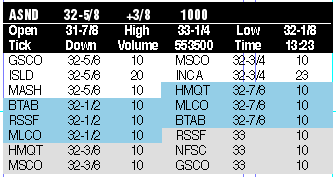NEW TECHNIQUES
by Mark Conway
Many traders in the stock market are moving to short-term approaches and taking advantage of today's technology. Here's a walk through the basics.
Welcome to the battlefield of electronic daytrading. The confluence of technology and trading has created a network of daytraders with access to real-time quotes, news and instantaneous executions. Of all markets that daytraders have access to, NASDAQ (the North American Stock Dealers Automated Quotation system) has emerged over the past several years as a primary trading arena.
Each NASDAQ stock is represented by a group of market makers and electronic communication networks (ECNs) that compete for bids and offers. Market makers are represented by institutions such as Goldman Sachs, Merrill Lynch and Morgan Stanley. ECNs are private trading networks that are offered to the public through a limited number of brokers. These brokers give traders access to the Small Order Execution System (SOES) -- Instinet, SelectNet, the Island and others.
The best (highest) bid and the best (lowest) offer represent the inside market. Typically, a stock quote is given as the current bid and asked price and is known as a Level I quote. For a Level II quote, all the market maker bid and asked prices are shown; all the bid prices are shown in descending order (highest to lowest) and all the asked prices are shown in ascending order (lowest to highest). Software vendors display Level II quotes in a market maker window implemented in the style that can be seen in Figure 1.
In Figure 1, the bids are shown on the left-hand side and offers on the right-hand side. The current quote for Ascend [ASND] is 32-5/8 bid, 32-3/4 offered. Each price tier is color-coded; thus, there are three bids at 32-5/8 and two offers at 32-3/4. Each bid or offer is represented by a market maker or ECN acronym, the price, and the size in hundreds. For example, Goldman Sachs [GSCO] is bidding 32-5/8 for 1,000 shares of ASND. Someone on the Island ECN[ISLD] is bidding 32-5/8 for 2,000 shares, and someone on Instinet [INCA] is offering 2,300 shares of ASND at 32-3/4.

FIGURE 1: QUOTES. Software vendors display Level II quotes in a market maker window. Here, the bids are shown on the left-hand side and offers on the right-hand side. Each price tier is color-coded; each bid or offer is represented by a market maker or ECN acronym, the price, and the size in hundreds. For example, Goldman Sachs [GSCO] is bidding 1,000 shares of ASND. Someone on the Island ECN [ISLD] is bidding 2,000 shares, and someone on Instinet [INCA] is offering 2,300 shares of ASND.